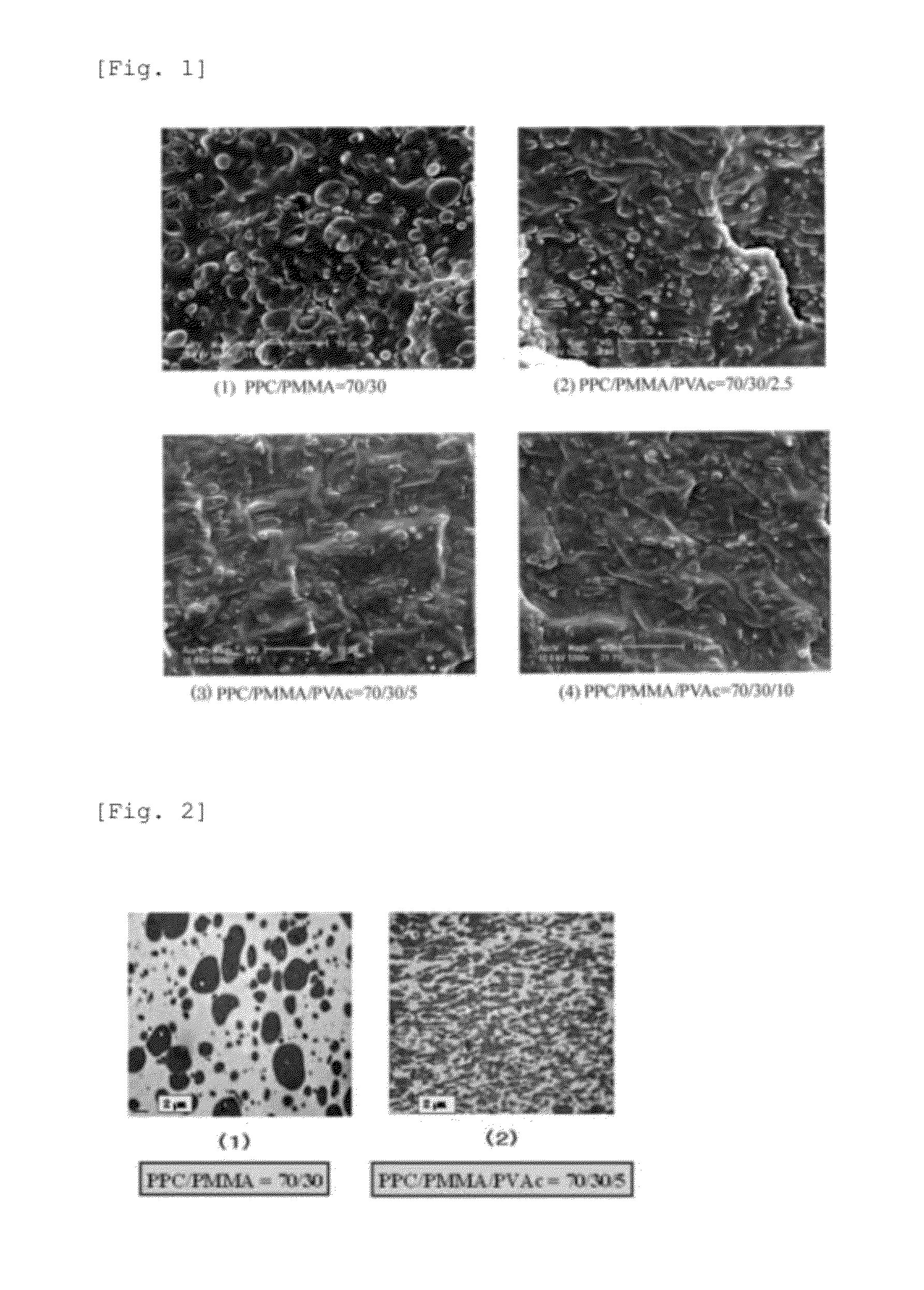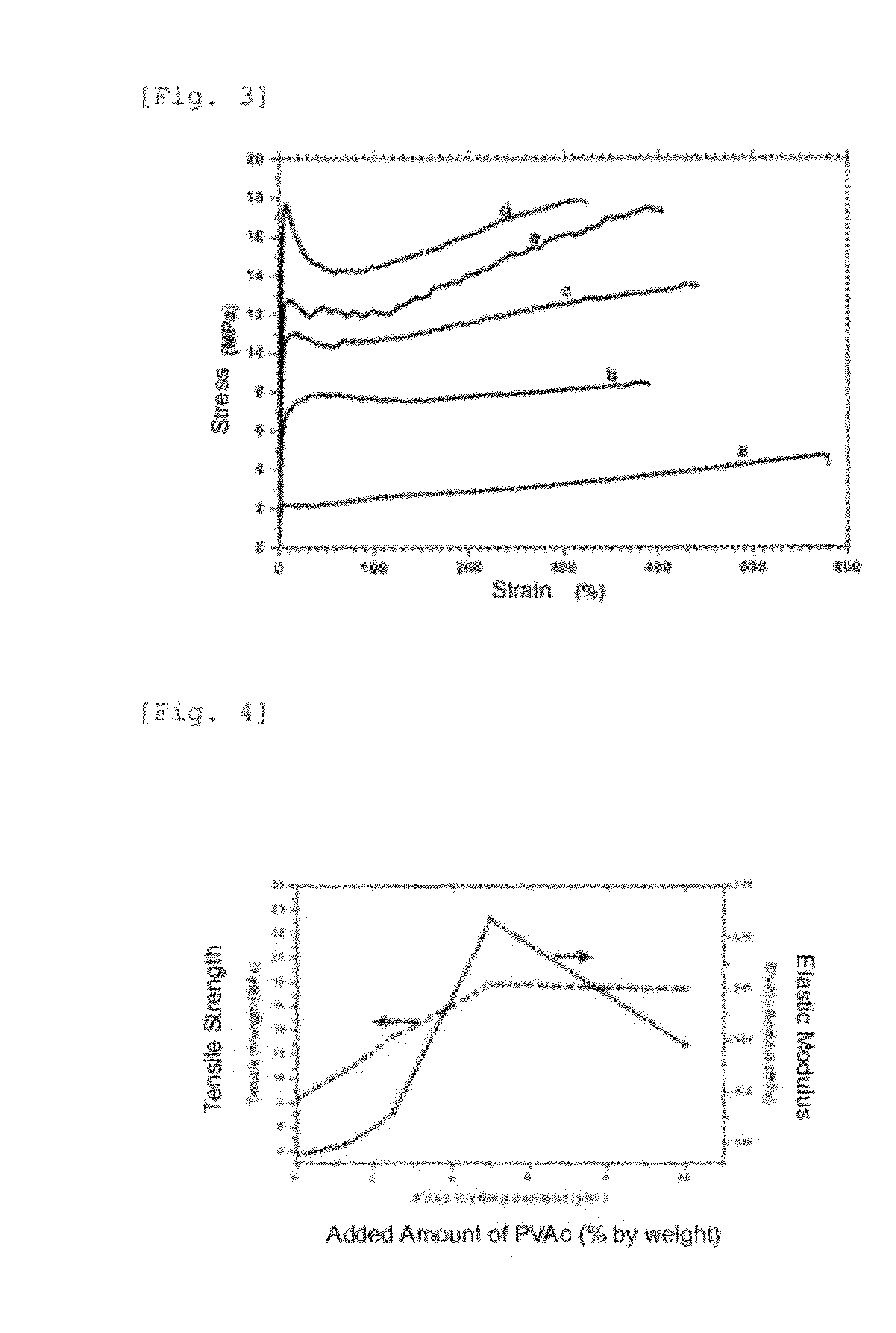Ternary blends of aliphatic polycarbonate derived from carbon dioxide, and process for producing same
- Summary
- Abstract
- Description
- Claims
- Application Information
AI Technical Summary
Benefits of technology
Problems solved by technology
Method used
Image
Examples
example 1
[0089]An example of the invention is described in which, as a ternary polymer blend, a carbon dioxide-derived aliphatic polycarbonate blend is produced from PPC, PMMA and PVAc. In this example, the starting material PPC used is one produced by Changchun Institute of Applied, Chinese Academy of Sciences and having the properties shown in Table 1.
Mn ( )GPC (mobile phase methyleneMw ( )447000dichloride)PDI4.14fugitive constituent(%)0.3ash content (%)0.7propylene carbonate2.3calculate from 1H-NMRcontent (%)Tg (° C.)30.5DSO (N 10 K / min) indicates data missing or illegible when filed
[0090]As for polymethyl methacrylate (PMMA), Sumipex LG21 (trade name) from Sumitomo Chemical was used.
[0091]As for Polyvinyl acetate (PVAc), one produced by Scientific Polymer Product Inc. and having a weight-average molecular weight (Mw) of 260000 was used.
production examples 1 to 4
[0092]PPC and PVAc were dried in vacuum at 45° C. to 50° C. for 24 hours and PMMA was dried in vacuum at 80° C. for 24 hours, and thereafter these were weighed each in a predetermined amount, put in one container and fully stirred and mixed therein at room temperature. Predetermined amount as referred to herein means that, to a composition of a binary blend which is prepared to comprise from 97 to 50% by weight of PPC and from 3 to 50% by weight of PMMA, a third component Polyvinyl acetate (PVAc) is added in an amount of 0% by weight (Production Example 1) relative to 100% by weight of the total of the binary blend, 2.5% by weight (Production Example 2), 5% by weight (Production Example 3) or 10% by weight (Production Example 4) . About 5 g of the mixture was put into a micro-volume high-shear processing machine (Imoto Machinery's HSE3000mini), heated and melted at 155° C., kneaded for from 3 to 5 minutes at a screw rotation number of 100 rpm, and extruded out through the T-die. The...
production examples 5 to 8
[0093]PPC and PVAc were dried in vacuum at 45° C. to 50° C. for 24 hours and PMMA was dried in vacuum at 80° C. for 24 hours, and thereafter these were weighed each in a predetermined amount, put in one container and fully stirred and mixed therein at room temperature. Predetermined amount as referred to herein means that, to a composition of a binary blend which is prepared to comprise from 97 to 50% by weight of PPC and from 3 to 50% by weight of PMMA, a third component polyvinyl acetate (PVAc) is added in an amount of 0% by weight (Production Example 1) relative to 100% by weight of the total of the binary blend, 2.5% by weight (Production Example 2), 5% by weight (Production Example 3) or 10% by weight (Production Example 4). About 50 g of the mixture was put into a Banbury-type small-sized kneader (Toyo Seiki Seisaku-Sho's KF70V), heated and melted at 155° C., and kneaded for from 3 to 5 minutes at a screw rotation number of 100 rpm. The process gave an extrudate having a good ...
PUM
| Property | Measurement | Unit |
|---|---|---|
| Temperature | aaaaa | aaaaa |
| Percent by mass | aaaaa | aaaaa |
| Percent by mass | aaaaa | aaaaa |
Abstract
Description
Claims
Application Information
 Login to View More
Login to View More - R&D
- Intellectual Property
- Life Sciences
- Materials
- Tech Scout
- Unparalleled Data Quality
- Higher Quality Content
- 60% Fewer Hallucinations
Browse by: Latest US Patents, China's latest patents, Technical Efficacy Thesaurus, Application Domain, Technology Topic, Popular Technical Reports.
© 2025 PatSnap. All rights reserved.Legal|Privacy policy|Modern Slavery Act Transparency Statement|Sitemap|About US| Contact US: help@patsnap.com



